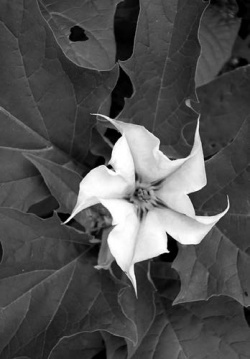Psychoactive Plants in Tantric Buddhism
Psychoactive Plants in Tantric Buddhism
Cannabis and Datura Use in Indo-Tibetan Esoteric Buddhism
by R. C. Parker and Lux
This article represents a fairly comprehensive survey of references to datura and cannabis in Indo-Tibetan tantric Buddhist texts that have been translated into English. The online version includes more Tibetan and Sanskrit transliterations, links to referenced articles, and additional related material. See Erowid.org/extracts/n14/tantra. The authors wish to thank Professor David B. Gray and Professor Geoffrey Samuel for their encouragement and many helpful suggestions.
Since the beginning of modern discourse about psychedelics in American intellectual culture, seminal authors have noted parallels between psychedelic experiences and contemplative practices of Asia. In his 1954 essay The Doors of Perception, Aldous Huxley likened his experience of mescaline to the insights precipitated by yoga and meditation. Author R. Gordon Wasson went further, arguing that some spiritual disciplines of India may be intended to evoke an experience that was originally entheogenic in nature.[1]
By the late 1960s, counterculture rhetoric strongly associated psychedelics and Eastern mysticism. Alan Watts tackled the topic in his 1962 book The Joyous Cosmology; Timothy Leary, Ram Dass, and Ralph Metzner later wrote a guide to psychedelic experiences based on the fourteenth-century tantric manual Bardo Thödol, the so-called Tibetan Book of the Dead.[2]
Psychedelic experience and Eastern meditation have become so intertwined in Western culture that their roots are difficult to disentangle. Fortunately, in recent years several thoughtful book chapters and articles have appeared examining the complex relationship between the explosion of psychedelic counterculture and the contemporaneous popularization of Buddhism in the United States in the 1950s and 1960s.[3]
Unfortunately, the history of psychoactive plant use by Buddhists in Asia has not been addressed with comparable rigor. Although interesting speculative work has been written on the subject,[4],[5] a focused analysis of explicit textual evidence has not been published. Over the last few decades, university religious studies departments have produced translations of Buddhist tantric texts of unprecedented quality, providing ample material for an examination of psychoactive plant use by Buddhists in Asia. This article considers some of the evidence with respect to tantric Buddhism in India and Tibet, focusing on the use of cannabis and datura.
- Psychedelic experience and Eastern meditation have become so intertwined […] that their roots are difficult to disentagle.
Tantric Buddhism
The term “tantra” refers to a great many religious practices and beliefs. It is so difficult to define, that some religious historians argue the word has little meaning other than to mark extreme or taboo practices.[6] The Sanskrit word and its Tibetan equivalent (rgyud) refer to the texts that form the scriptural basis for the religious movement, and also mean “continuum” or “lineage”.
Despite the difficulty in pinning down the term, different tantric lineages generally share some characteristics. Practices and scriptures are often secret, with instructions given in private by teachers to students with whom they have consecrated a formal guru/disciple relationship. Many tantric practices must be authorized by empowerment ceremonies, which sometimes last for days or weeks and may carry lifelong practice commitments as a condition of receiving them.
Most tantric scriptures are practiceoriented texts associated with specific deities. Tantric meditation and ritual often involve complex visualizations of these deities—so much so that the Tibetan polymath Tsong Khapa (1357–1419) proposed “deity yoga” as the defining characteristic of tantra. [7] Many tantric yogas are intended to elicit extraordinary states of consciousness, including sexual yoga with real or visualized partners and energy yogas that manipulate body heat, respiration, or dreaming.
The concept of tantra as a sex-positive religion devoted to embracing the material world is a modern construction that bears little resemblance to the historical tantric practices and beliefs of Asia.[8]
Tantra began to take shape as a major religious movement in India between the sixth and ninth centuries CE.[9],[10] Many of the extant tantric texts were written in these years and the movement reached a peak that lasted several centuries. Most tantras were composed in Sanskrit in India and Central Asia, and many were eventually exported to China and Tibet.
During 950–1200 CE, Tibet underwent a period of upheaval followed by a “renaissance”, in which the old Tibetan empire collapsed and reorganized into a society ruled by a complex network of powerful clans and religious institutions. [11] During this renaissance, enormous resources and labor were devoted to painstakingly translating Buddhist scriptures from Sanskrit into Tibetan. The Tibetan written language had been developed during the seventh century by a committee of religious scholars specifically for the purpose of translating scriptures from Sanskrit. [12] Many Buddhist tantras that are lost in their original Sanskrit forms still exist in the Tibetan scriptural canon.
Source
- ↑ Wasson RG. Soma: Divine Mushroom of Immortality. Harcourt. 1972.
- ↑ Leary T, Metzner R, Alpert R. The Psychedelic Experience: A Manual Based on the Tibetan Book of the Dead. Citadel. 1964.
- ↑ Badiner AH, Grey A. Zig Zag Zen: Buddhism and Psychedelics. Chronicle Books LLC. 2002.
- ↑ Crowley M. “Secret Drugs of Buddhism.” E-published in Earthrites Magazine. Accessed Apr 9, 2008; http://earthrites.org/magazine_article_drugplants_crowley.htm.
- ↑ Hajicek-Dobberstein S. “Soma Siddhas and Alchemical Enlightenment: Psychedelic Mushrooms in Buddhist Tradition”. J Ethnopharmacol. Oct 1995;48(2):99–118.
- ↑ Urban HB. Tantra: Sex, Secrecy, Politics, and Power in the Study of Religion. University of California Press. 2003.
- ↑ Dalai Lama HH (Tenzi n Gyatso), Tsong-kha-pa, Hopkins PJ. Tantra in Tibet. Snow Lion Publications. 1987.
- ↑ White DG. Kiss of the Yoginé: “Tantric Sex” in its South Asian Contexts. University of Chicago Press. 2006.
- ↑ White DG. The Alchemical Body: Siddha Traditions of Medieval India. University of Chicago Press. 1996. p 19,118–9,412.
- ↑ Davidson RM. Indian Esoteric Buddhism: A Social History of the Tantric Movement. Columbia University Press. 2003. p 201.
- ↑ Davidson RM. Tibetan Renaissance: Tantric Buddhism in the Rebirth of Tibetan Culture. Columbia University Press. 2005.
- ↑ Snellgrove D, Richardson H. A Cultural History of Tibet. Frederick A. Paeger, Inc. 1968.
